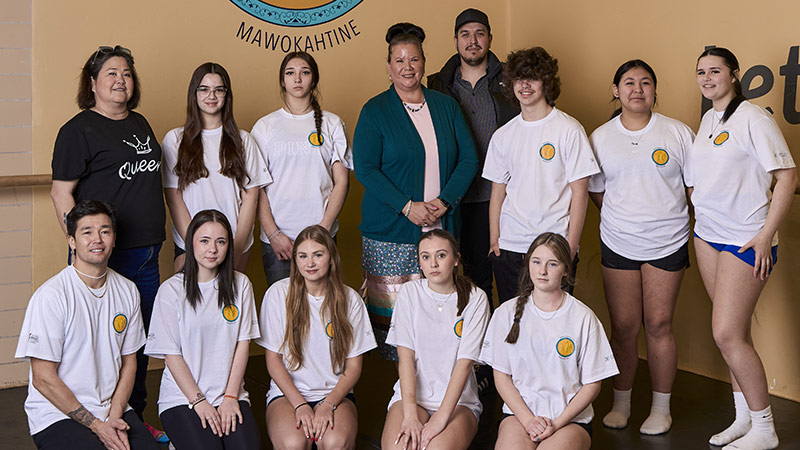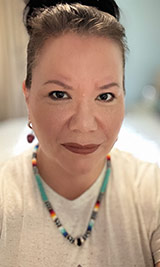How a UNB alum helped launch Canada's first Indigenous dance school
Author: Hilary Creamer Robinson
Posted on Jul 3, 2025
Category: UNB Fredericton

In recognition of the 10-year anniversary of the Truth and Reconciliation Commission’s 94 Calls to Action, we’re sharing stories of how the UNB community is honouring those calls. Here, we share how one UNB alum has turned lived experience and education into powerful impact.
This September, Canada’s first professional Indigenous dance school is welcoming its inaugural cohort.
The New Brunswick-based program has been given life in large part to Natasha Martin-Mitchell (C-LS'16, BIS'16, MEd'18) from Listuguj Mi’gmaq First Nation.
Martin-Mitchell holds a bachelor of integrated studies and a master of education from the University of New Brunswick (UNB).
A multidisciplinary artist and advocate, Martin-Mitchell has spent over two decades creating space for the well-being and recognition of First Nations, Métis and Inuit peoples and communities.
She is also a board member and board chair governance of Atlantic Ballet Indigenous.
When the company was casting for its first Indigenous production, Pisuwin, Martin-Mitchell became aware of a startling truth.
“There are only five professional Indigenous dancers in Canada,” she said. "So, we thought, ’What can we do to create new dancers in this field?’”
Ever the leader, Martin-Mitchell and a passionate team of collaborators set out to build Mawiamalga’tijig/Mawokahtine: Intercultural Dance Program.
The first program of its kind in the country, Mawiamalga’tijig/Mawokahtine—which translates to “they dance together”—gives high-school-aged First Nations, Métis and Inuit dancers the training needed to pursue a professional career in traditional and contemporary Indigenous dance.
Dancers will be trained in Indigenous dance, ballet and choreography while earning the high school credits needed to graduate on time.
“Nothing like this has ever been done before,” said Martin-Mitchell. “By offering this program, we are breaking down doors and removing barriers.
“We’re honouring old traditional dances that were thrown away and forgotten during the residential school era. We’re bringing them back to the world.”
The school’s innovative model, developed by Martin-Mitchell and Nipahtuwet Naka Wespahtuwet Possesom (Possesom Paul), director of Indigenous programming at Atlantic Ballet, is Indigenous-led and guided by knowledge from community Elders.
“When we developed the program, we said, if we’re going to do it then let’s do it right,” Martin-Mitchell said.
Along with Possesom Paul, Elders and collaborators from Atlantic Ballet, Martin-Mitchell worked with New Brunswick’s Department of Education and Early Childhood Development to ensure students are set up for educational success.
Last winter, nine dancers from across the province were selected for the two-year program, which is set to begin this September in Moncton.
For one week each month, dancers will live in a home where Indigenous chaperones, who have been trained to provide support and guidance, will provide 24-hour care.

“We are going to be there for the dancers and help them through their young lives,” Martin-Mitchell said as she recalled meeting the dancers for the first time last March, and hearing some of their stories.
“This is a place just for them.
“I told the dancers, when you come into the house, the room you are given is yours alone for the next two years. No one is going to take your pillows or your belongings. You can leave whatever you want here. Your things will not be touched. It is your room alone.”
Martin-Mitchell acknowledged that many of the dancers will arrive with trauma. With that knowledge, group and individualized support have been worked into the curriculum.
“When the dancers arrive each week, we will have a ceremony, a talking circle, and we will close each week with one as well,” she said.
“The ceremonies are meant to unburden our dancers when they arrive. For that one week, you can be you. Not the older brother, sister or caregiver. You get to be you.
“This is where you get to become who you need to be.”
During the weeks they aren't training, dancers will live in their home communities. And when they graduate, they will be equipped with both the technical and business skills required for a successful career in professional dance.
“[During auditions last winter] some of the parents didn’t realize how big the program was,” Martin-Mitchell said. “When we were explaining that dancers will be taught the fundamentals of running their own businesses, they were in shock,” she said of the school’s partnership with the Joint Economic Development Initiative’s Aboriginal Development Fund.
“They will be entrepreneurs. We want to make sure they have the tools they need to be successful,” she said.
“We have also connected with principals and guidance counsellors so that there is no area in which our dancers are not supported.”
The program is funded with support from the provincial and federal governments, and the Ulnooweg Indigenous Communities Foundation, which has contributed significantly by furnishing the house in which the dancers will live during their weeks in studio.
During orientation week, the mother of one dancer said she would take a second job so her daughter could participate in the program, Martin-Mitchell shared.
“I told her she didn’t have to,” she said.
All costs for the dancers will be covered, from travel to food, accommodation, tutors, costumes and dance clothes.
“This experience could change the trajectory of the lives of these young people,” Martin-Mitchell said.
“[That same week] when I first saw the dancers on stage, I got chills. It was such a profound moment. My eyes teared up with pride.”
